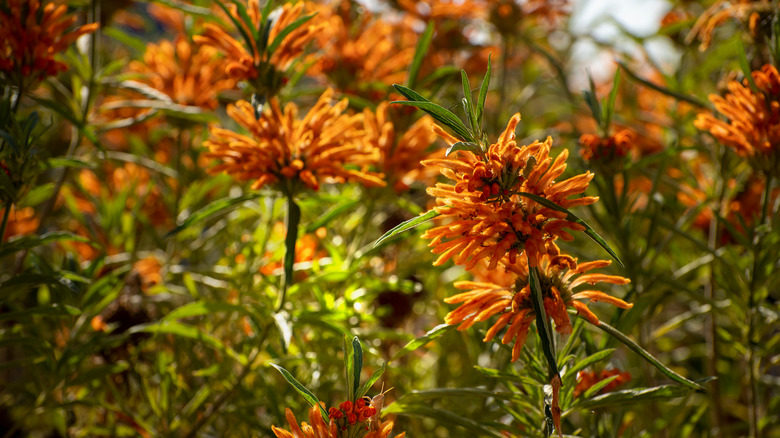Must-Know Tips For Growing Lion's Ear From Seed To Attract Wildlife
Choosing a landscape that enhances the ecosystem is a great way to attract pollinators and wildlife to your backyard. Planting flowers and shrubs that support biodiversity helps plants, animals, and insects co-benefit one another. One shrub that can bring your backyard to life is the vibrant lion's ear. This perennial shrub is known for its wild and gorgeous tubular orange flowers that bloom on long stems from late summer to early fall. The plant belongs to the mint family and thrives in Hardiness Zones 8 to 11 — it attracts hummingbirds to your garden, as well as butterflies and bees. Some choose to grow the flowering shrub for borders, so having more than one plant is pretty common. And a simple way to multiply lion's ears is to plant them from seed at home.
Lion's ear is a fast-growing plant that takes about six months to a year to mature, reaching up to 5 feet tall. The plant can be sown directly in the ground, or gardeners can germinate seeds indoors. To ensure success, there are a few items to keep in mind to ensure your lion's ear sprouts, such as the right temperature and making sure the seedlings have enough light. But if all goes well, once the seedlings become established, the small plants should settle in with ease – here are some tips to consider!
Germinate seeds indoors
One way to get ahead of growing lion's ear is to start seeds indoors and then transplant your seedlings outdoors once the probability of a frost has passed. For this particular method, you will need a seed tray, seed-sowing mix, a plastic flat, and of course, your seeds. After you fill the planting packs with soil, evenly spread your seeds and pat them down without fully burying them in the dirt. Afterward, add about 1 inch of room temperature water to your tray, which is where you will set your seedling container. This way, the soil can absorb moisture through the drainage holes and you don't have to worry about overwatering issues that can arise. When the soil appears moist, remove your container from the tray, and repeat this process throughout the germination period.
To speed up seedling development, placing plastic wrap over your container is a helpful trick that effectively keeps moisture in. Other crucial steps during germination include placing your seeds in a spot that receives full sun, such as near a south-facing window. Also, the room temperature needs to be about 65 degrees Fahrenheit for the seeds to turn into seedlings. This process usually takes about 20 days. When you start to notice little plants sprouting you can remove the plastic and move the seedlings to larger containers when they outgrow their tray.
Plant outdoors after last frost
You can transplant your seedlings outside when temperatures are consistently mild with no chance of a cold snap. The young lion's ear plants should be transplanted into a compost-rich garden bed when they reach about 1 foot and 3 inches high. Cover the lion's ears with organic mulch for optimal growth, and water your little shrubs about once a week. To avoid the risk of your young plants struggling in their new environment, follow protocols to avoid transplant shock. If all goes well, healthy plants can flower in the first or second growing season.
If you want to skip germinating seeds and live in a subtropical climate, you can plant the seeds directly in your garden. In this case, choose an open sunny spot, keep the soil moist, and let nature do its work. If you have an existing lion's ear plant, you can collect your seeds for planting from the pods. Though it should be noted that, while lion's ear does reseed every now and again, it's often not enough to count on an abundance of new plant growth.


